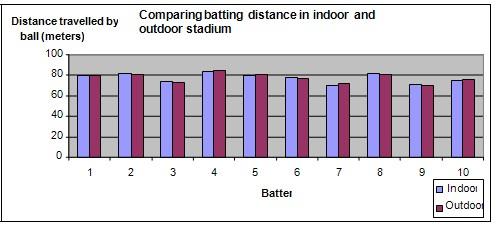| Complexity level: | 6 |
| Project cost ($): | 20 |
| Time required: | 1 hour to prepare, 1 day for this science project experiment |
| Material availability: | Easily found |
| Safety concerns: | Basic safety requirements |
Hypothesis
Baseball batters will hit a baseball further in an outdoor stadium than in an indoor stadium.
Overview
Baseball
Baseball is a game that is played using a ball and a bat. The game is composed of two teams of nine players each and the game is played on a field which has a square circuit, called a diamond. The diamond is defined by four bases in the corners. The goal of the game is for the batter to hit the ball which is thrown by the pitcher of the opposing team. The batting team will then try to score runs by running and touching the bases. The pitcher’s team or the fielding team will try to stop the batter’s team from reaching the bases. The team with the most runs at the end of the game wins.
In America, the baseball game was originally played indoors in the 1900s. However, when basketball started to gain popularity in the 1910s, baseball games started to move out of the gymnasiums and into the outdoor grass and dirt fields. Modern day baseball stadiums are either open fields or an indoor stadium with retractable roofs.
Baseball is a very popular team sport in North America, South America, the Caribbean and some parts of Asia. North America has the Major League Baseball which consists of the National League and the American League. Baseball is also a very popular sport in Japan and Cuba. Japan has its Central League and Pacific League while Cuba has its own West League and East League.
Materials
The materials required for the science fair project:
- An outdoor baseball stadium
- An indoor baseball stadium
- 10 baseball batters
- 1 baseball pitcher
- 10 baseball bats and 1 baseball glove for the pitcher
- 2 dozen baseballs
- 1 set of baseball safety gear for the batter. 1 set of baseball safety gear for the pitcher
- A measuring tape
- An assistant
Procedure
1. For this science fair project, the independent variable is the type of baseball stadium – indoor or outdoor. The dependent variable is the distance traveled by the baseball. This is determined by using the measuring tape to measure the distance travelled by the baseball. The constants (control variables) are the skill of the batter, the skill of the pitcher and the type of baseball used.
2. The baseball batters are tagged with numbers 1 to 10. They are then brought to the indoor baseball stadium and asked to warm up.
3. Batter Number 1 is asked to get ready with his bat. The pitcher will take his position and will begin pitching. Allow them to practice for a while. Once they are ready, begin the experiment - once the batter has hit the ball, the distance traveled by the ball is measured. The same batter will hit a pitched ball 5 times and the furthest distance traveled by the ball is recorded in the table given below.
4. Procedure 3 is repeated with the remaining 9 baseball batters. The furthest distance traveled by the ball after 5 hits by each batter is measured and recorded in the table given below.
5. The batters are next brought to the outdoor baseball stadium. They are again asked to warm up and Procedures 2, 3 and 4 are repeated with the same 10 batters. The furthest distance traveled by the ball after 5 hits by each batter is measured and recorded in the table given below.

Results
The results show that there is no significant difference in the distance traveled by the ball when batted in the indoor or outdoor stadium.
| Stadium type | Average distance traveled by the ball (meters) | |||||||||
| 1 | 2 | 3 | 4 | 5 | 6 | 7 | 8 | 9 | 10 | |
| Indoor | 79.5 | 81.2 | 73.7 | 83.8 | 79.7 | 77.3 | 69.9 | 80.9 | 70.4 | 74.8 |
| Outdoor | 79.8 | 80.6 | 72.6 | 84.3 | 80.1 | 76.7 | 71.3 | 80.5 | 69.7 | 75.4 |
The graph below represents the results of our science experiment.

Conclusion
The hypothesis that a baseball batter will hit the ball further in an outdoor stadium than in an indoor stadium is disproved.
Baseball is a game that is meant to be played outdoors in the grass and dirt fields. However, in some parts of America, weather conditions do not allow people to play baseball for up to 6 months in a year. This gives rise to demand for indoor baseball stadiums to be built. Studies show that there are no significant differences in the performance of baseball players, regardless of stadium type - as long as there is adequate lighting. The first indoor stadium to be used in major league baseball was the Houston Astrodome, in 1965. The Astros called it home from 1965 to 1999.
Also consider
This science fair project can also be done by comparing the performance of batters at higher or lower altitudes. Studies show that at higher altitudes, baseballs travel at different speeds due to the lower air pressure. Also, what if the air temperature is higher? Does that affect how a baseball travels?
References
Baseball - http://en.wikipedia.org/wiki/Baseball
Sport: Indoor baseball - http://www.time.com/time/magazine/article/0,9171,762905,00.html

